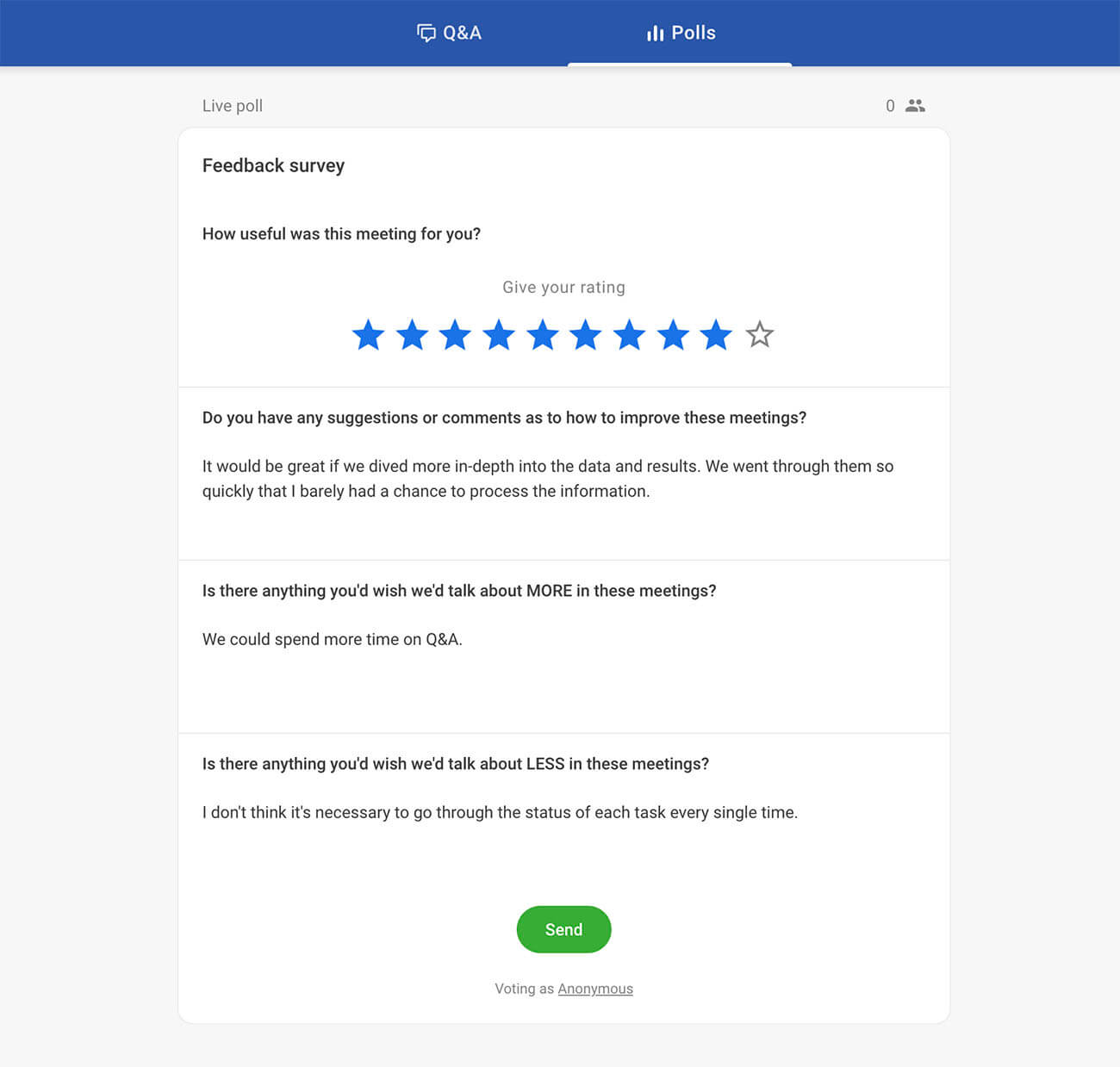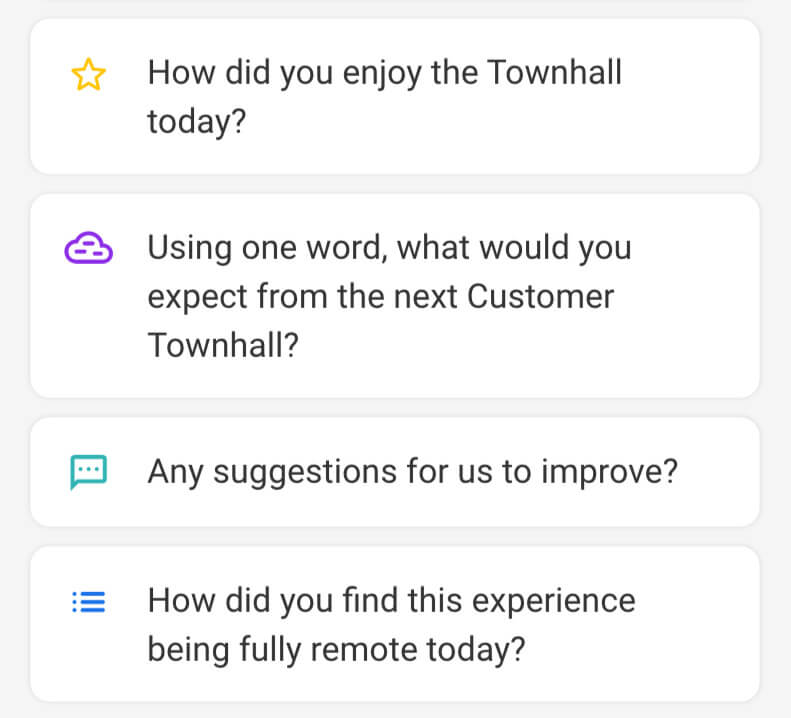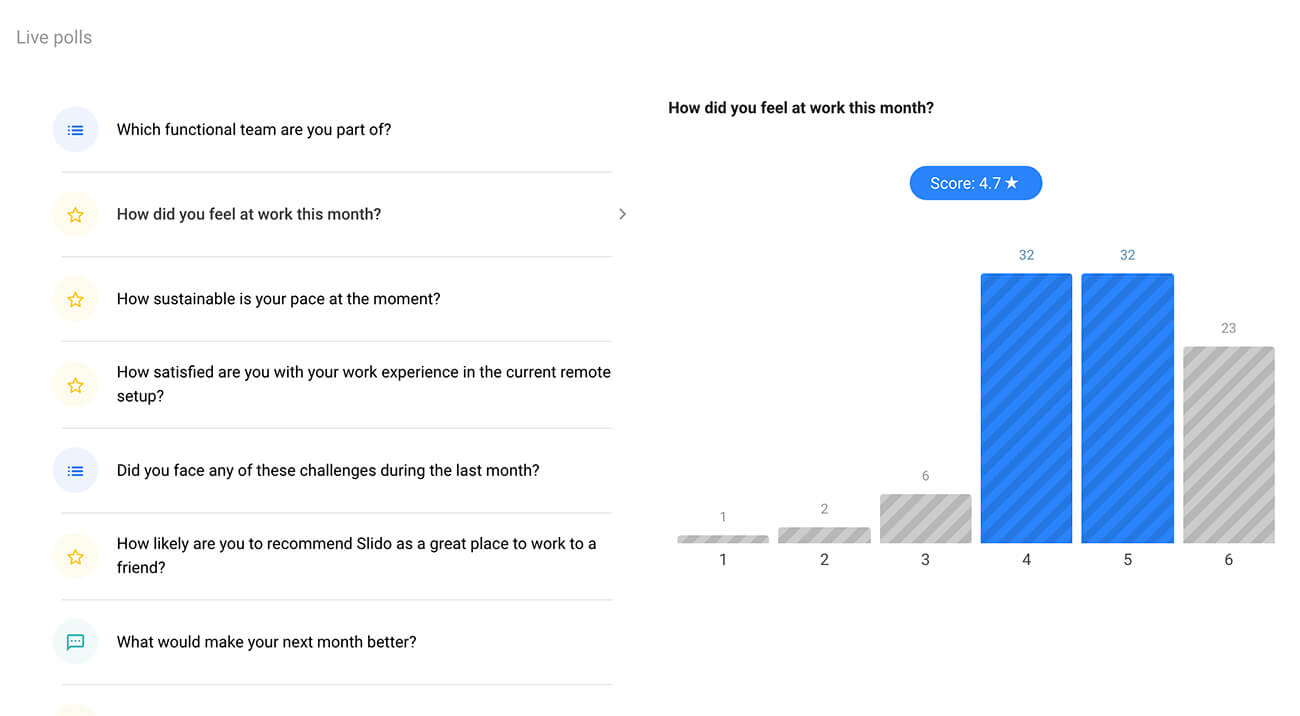We’re used to rating every Uber ride, meal delivery, or hotel – so why not meetings?
Running a feedback survey after your meeting helps you understand how valuable, enjoyable, or simply good your meeting was for your participants.
Within the survey, you can discuss different elements of the meeting and what worked best for participants, from opening icebreaker questions to the content of the meeting itself.
And just like our feedback helps Uber improve their service, a post-meeting feedback survey is an important asset for you to:
- Keep improving the quality of your meetings
- Refining your own skills as a meeting facilitator
- Ensuring that your meetings are reaching the intended goals
In this article, we’ll share tips on how to create your post-meeting feedback survey, how to evaluate it, along with 20+ survey questions you can use at your next meeting.
Why it’s important to ask your employees for feedback?
Employee feedback is one of the key employee engagement strategies that companies and teams can apply. And as Gallup’s research shows, year after year, engaged employees perform way better than other employees.
Employee feedback is also one of the most effective tools for CEOs, team leads, and project managers to uncover any critical issues or ideas for improvement. Without feedback, you’re in the dark about what your employees think and you can miss out on many opportunities for growth and innovation.
…and why it’s important to ask for feedback on meetings?
Meetings are crucial for team collaboration. As Jeetu Patel, SVP and General Manager of the Cisco Security and Collaboration unit said: “Meetings are a key way for companies to harness the collective brainpower of their teams.”
Feedback is a way to ensure that your meetings hit the mark.
If you lead a team, you don’t always know what’s on your team members’ minds. Often, you don’t even know whether the meetings that you host are valuable for your employees.
Asking for your employees’ feedback opens your eyes and ears to what your employees have to say. On top of that, giving your employees a safe space to provide their feedback goes a long way toward creating an open and transparent culture in your team.
How to create your post-meeting survey
A post-meeting survey is a simple, yet powerful tool to keep improving your meetings, making them more effective, but also keep improving your skills as a meeting host.
Whether it’s a large all-hands meeting, a company town hall, or a regular team meeting – ask your employees to evaluate the quality of your meeting. Find out what works and what doesn’t. Ask them what would make their meeting experience better.
To create your post-meeting survey:
- Create your Slido account (if you don’t have one already 🙂)
- Go to ‘Live polls’ and click ‘Create a survey’
- Combine rating polls for quick feedback and open text polls for more elaborate feedback
- Hit ‘Save’.
Your feedback survey can, for example, look like this:

20+ post-meeting survey questions ideas
A good post-meeting survey is short, snappy, and simple. Always make sure the questions are clear, to the point, and very easy to answer.
A good practice is to start with a quick rating poll where your participants use a classic star-rating scale. For example:
- How would you rate today’s meeting? (1-10)
- On a scale of 1-7, how useful was today’s meeting for you?
- How much did you enjoy today’s meeting?
- On a scale of 1-6, how relevant/interesting/enjoyable was today’s content for you?
- How excited are you about these meetings?
- Was this a valuable use of your time? (1-not really, 10-absolutely)
And don’t forget to include an open text poll. An open text field allows your meeting participants to elaborate on their ratings and provide more in-depth feedback. For example:
- What would make our meetings more effective?
- Do you have any suggestions or comments as to how to improve these meetings?
- Is there anything you wish we’d talked about more/or less during these meetings?
- What content resonated with you the most today?
- Do you have any feedback for me?
- What’s the most useful part of this meeting?
- If you could change one thing about this meeting, what would it be?
- What can we do to improve the meeting experience for our remote colleagues?
- Do you have any ideas on how we can improve our team collaboration?
- What is your key takeaway from today’s session?
But, you can combine many different poll types. For example, this is a survey that our VP of Success, Jo Massie, ran during one of our Customer Townhalls. In her post-meeting survey, she combined a rating poll, a word cloud, an open text poll, and a multiple choice poll.
- How did you enjoy the Townhall today? (rating)
- Using one word, what would you expect from the next Customer Townhall? (word cloud)
- Any suggestions for us to improve? (open text)
- How did you find this experience, being fully remote today? (multiple choice)

You can also go more in-depth and include more team culture-related questions in your survey. For example:
- On a scale of 1-7, how did you feel at work this month?
- How sustainable is your work pace at the moment? (1-not at all sustainable/close to burning out, 7-sustainable)
- How satisfied are you with your current work setup?
- What are the main challenges that you face in your work/in this team?
How to evaluate your survey?
Now, what to do with the survey results?
Use Slido Analytics to get a clear overview of your employees’ input. You can export all your data into PDF or XLS files to further work with the insights and create a report from each survey.

Analyze your employees’ responses in rating polls. If you’re planning on running your meeting surveys regularly, you’ll be able to keep track of the average scores month by month and monitor progress.
Then, read through the comments from your open text polls. Keep an eye on common topics and recurring issues. If there’s a comment or several comments that are particularly negative, use these to drive a discussion.
Read also: 3 Employee Engagement Strategies & How to Measure Them
How to make sure you get the responses you need?
You might be asking: How to motivate people to actually fill out the survey? We have a secret tip for you:
Ask your meeting attendees to fill it out while you’re all still at the meeting. Dedicate the last 2 minutes of your meeting time to feedback, and shortly before you wrap the meeting up, activate the Slido survey and ask your team to fill it out.
Of course, you can also share a link to your Slido survey with your meeting participants afterward, for example, via a follow-up email or in your team’s internal communications channel.
But, from our own experience, you’ll get far more responses if you ask your attendees to complete the survey while still at a meeting. At Slido, we even added the feedback as a separate point on our all-hands meeting agenda!
Read also: Why and How We Run Our Monthly Employee Pulse Surveys
Last but not least…
Don’t just collect the feedback for the sake of feedback. Act on it! Step by step, try to implement people’s feedback and suggestions in the next sessions. When your teammates see that you take their opinions into account, they’ll be even more open and likely to share their thoughts.
Good luck!




